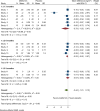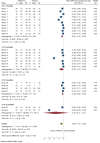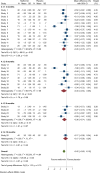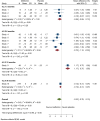An Updated Systematic Review and Meta-Analysis on the Efficacy and Safety of Metformin as Add-on Therapy to Insulin in Patients With Type 1 Diabetes
- PMID: 40512873
- PMCID: PMC12165280
- DOI: 10.1002/edm2.70060
An Updated Systematic Review and Meta-Analysis on the Efficacy and Safety of Metformin as Add-on Therapy to Insulin in Patients With Type 1 Diabetes
Abstract
Introduction: This study aims to perform an updated meta-analysis evaluating the efficacy and safety of metformin adjunct therapy in type 1 diabetes mellitus (T1DM) patients.
Method: Cochrane, PubMed and Embase were searched for randomised controlled trials (RCTs) that reported the efficacy and safety of metformin in T1DM patients. Statistical analyses were performed using STATA software.
Results: Twenty-nine placebo-controlled RCTs enrolling 2051 T1DM patients were included. Adolescents experienced a notable reduction in total insulin daily dose (TIDD) (mean difference [MD] = -0.61 [95% confidence interval (CI): -1.02, -0.20] units/kg per day) and levels of haemoglobin A1c (HbA1c) (MD = -0.45 [95% CI: -0.79, -0.11]), total cholesterol (TC) (MD = -0.78 [95% CI: -1.54, -0.02]), and low-density lipoprotein (LDL) (MD = -0.69 [95% CI: -1.36, -0.02]) at 3 months of follow-up with metformin. In adults, metformin significantly reduced Body Mass Index (BMI) (MD = -0.71 [95% CI: -1.23, -0.19]), TIDD (MD = -0.44 [95% CI: -0.73, -0.16]), and levels of HbA1c (MD = -0.70 [95% CI: -1.10, -0.30]) and TC (MD = -0.60 [95% CI: -1.09, -0.10]) at 6 months. The risk of gastrointestinal adverse events (GIAEs) was significantly higher in both adolescents (Relative Risk [RR] = 1.74 [95% CI: 1.38, 2.21]) and adults (RR = 3.24 [95% CI: 1.49, 7.02]). All of the above had p-values less than 0.05. The metformin group showed no differences in BMI Z-score, high-density lipoprotein (HDL) level, or diabetic ketoacidosis (DKA) risk. No statistical difference was identified for any of the outcomes at other follow-up endpoints.
Conclusions: Metformin may reduce TIDD and levels of HbA1c, TC, triglycerides (TG), and LDL in T1DM adolescents. BMI, TIDD, and levels of HbA1c and TC may decrease in adults. Moreover, it may raise the risk of GIAEs in both age groups.
Keywords: meta‐analysis; metformin; type 1 diabetes mellitus.
© 2025 The Author(s). Endocrinology, Diabetes & Metabolism published by John Wiley & Sons Ltd.
Conflict of interest statement
The authors declare no conflicts of interest.
Figures









Similar articles
-
The effect of adding metformin to insulin therapy for type 1 diabetes mellitus children: A systematic review and meta-analysis.Pediatr Diabetes. 2017 Nov;18(7):664-673. doi: 10.1111/pedi.12493. Epub 2017 Feb 1. Pediatr Diabetes. 2017. PMID: 28145083
-
Metformin for women who are overweight or obese during pregnancy for improving maternal and infant outcomes.Cochrane Database Syst Rev. 2018 Jul 24;7(7):CD010564. doi: 10.1002/14651858.CD010564.pub2. Cochrane Database Syst Rev. 2018. PMID: 30039871 Free PMC article.
-
Insulin and glucose-lowering agents for treating people with diabetes and chronic kidney disease.Cochrane Database Syst Rev. 2018 Sep 24;9(9):CD011798. doi: 10.1002/14651858.CD011798.pub2. Cochrane Database Syst Rev. 2018. PMID: 30246878 Free PMC article.
-
Glucose-lowering agents for treating pre-existing and new-onset diabetes in kidney transplant recipients.Cochrane Database Syst Rev. 2017 Feb 27;2(2):CD009966. doi: 10.1002/14651858.CD009966.pub2. Cochrane Database Syst Rev. 2017. Update in: Cochrane Database Syst Rev. 2020 Jul 30;8:CD009966. doi: 10.1002/14651858.CD009966.pub3. PMID: 28238223 Free PMC article. Updated.
-
Systemic pharmacological treatments for chronic plaque psoriasis: a network meta-analysis.Cochrane Database Syst Rev. 2021 Apr 19;4(4):CD011535. doi: 10.1002/14651858.CD011535.pub4. Cochrane Database Syst Rev. 2021. Update in: Cochrane Database Syst Rev. 2022 May 23;5:CD011535. doi: 10.1002/14651858.CD011535.pub5. PMID: 33871055 Free PMC article. Updated.
References
Publication types
MeSH terms
Substances
LinkOut - more resources
Full Text Sources
Medical
Miscellaneous

